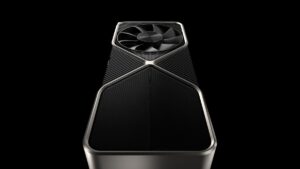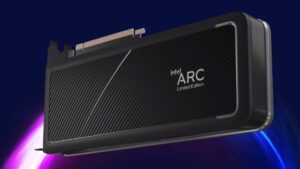After months of rumors, teasers, speculation, and the half-launch of the Arc A380 (opens in new tab), Intel has officially announced the Arc A310 graphics card (opens in new tab). It’s not the RTX 40 killer we might have hoped for, but it’s something. Given the amount of coverage of Arc in the tech press over the last couple of years, this announcement comes as a surprise. Whether it’s due to its modest nature or a it’s deliberate low-key release from Intel is up for debate. Nevertheless, such cards, while not appealing to gamers, have a place in the market.
The A310 is not a card you’d buy to play Cyberpunk 2077 at 4K with ray tracing. In fact, it’s not a card you’d use at 720p on minimum settings. Its specs show it’s designed to output video signals for machines that don’t have integrated graphics.
Key features include six Xe cores, 4GB of GDDR6 memory over a 64-bit bus, a graphics clock of 2000MHz and a 75W TDP. This means it’s competing with AMD’s RX 6400 (opens in new tab) and the more powerful integrated graphics equipped CPUs. There’s sure to be low profile options. Full height dual slot coolers would seem like overkill, though assuming partners launch their own versions, dual slot cards are sure to come.
I should not be bullying this little card. It has a couple of key features that are impressive, even if they are of limited usefulness. According to the official specifications, the A310 supports DisplayPort 2.0, a feature even the mighty RTX 4090 (opens in new tab) lacks. It also comes with AV1 (opens in new tab) encode and decode support. The competing AMD RX 6400 doesn’t even support AV1 decoding. Add to that and H.264 and H.265 encode and decode support and HDMI 2.1, and the little A310 looks like an impressive little home theatre PC graphics card.
At the time of writing, pricing and availability was unknown. In fact, its conceivable that the card may not make it to retail at all, instead finding its way into basic OEM office machines from the likes of Dell or HP.
The market for entry level graphics cards is shrinking, especially as AMD’s new Ryzen 7000 series CPUs (opens in new tab) all feature basic integrated graphics, and Intel’s non-F CPUs have for many generations. Perhaps the launch of a card such as this is something of a test case. Get the basics of the drivers working first and worry about gaming optimization later. With no hope of competing on merit with Nvidia’s RTX 40 series and AMD’s next Gen RDNA 3 cards, Intel’s low-key approach makes sense.












